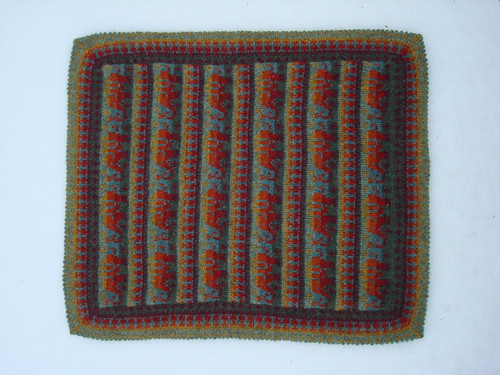
The finished measurement is 50 x 58 cm, to fit the pram.
I don't have the pattern, it's out of print, so I can't really say what my modifications are, but here's what I did:
In Starmore's design (which I just copied down from a photo), the background is 4 colors and the elephants 3 colors. Læsø Uldstue Klitgarn doesn't come in that many colors, so I couldn't find just that combination. Instead, I have 4 elephant colors and 3 background colors.
So then, I just knit a tube with 8 steek stitches, seamed through the steek a few times with the sewing machine, and cut it. Sounds easy. Then, a back-of-the-envelope calculation to find out how many edge stitches I should pick up with my gauge where 31 stitches x 33 rounds is 10 x 10 cm. My edge is different from the one in the pictures of the original Starmore design. I used the same pattern as in the main section, then just did some diamonds to make it a bit wider. Then, a k2tog, yo picot row, and then, knit the same pattern on the back. The front corners have m1, k1, m1 increases on every other row, the back corners have corresponding decreases on every other row. If I was to do this again (ha!), I would decrease a little more, as there was some surplus knitting in the corners on the back side.
Now came the difficult part. Or at least the part where I procrastinated for a good couple of months. The lining is corduroy, just cut to fit approximately, the edges closed on the sewing machine, and put between the layers of knitting. I seamed the knitting on to the corduroy rather loosely once, then permanently in every bind off stitch. An involved process, but really worth it in the end. Here's what the back looks like in the end:




